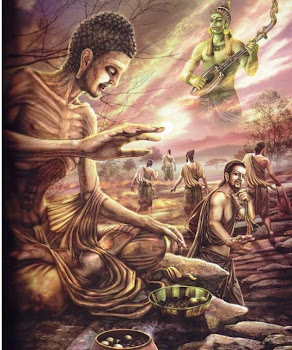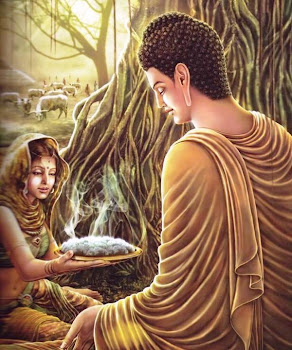သေခ်ၤေလးရပ္ တသိန္ထက္မွစ၍ ပါရမီဆယ္ပါး အျပားသုံးဆယ္တုိ႔ကုိ မနားမေန ျဖည့္က်င့္ ေတာ္ မူျပီးေနာက္၌ ဘုိးေတာ္အဥၨန သကၠရာဇ္ျဖဳိခ်ျပီး ႏွစ္ေပါင္းေတာ္ေတာ္ၾကေသာအခါ လူတုိ႔ သမုတ္အပ္ လူတုိ႔ အေလ့အျမတ္ ျပဳအပ္ေသာ ဘုရင္တဆူျဖစ္ေသာ မင္းသုေဒၶါဒန နန္းတက္ လာခဲ့သည္။ ေနာက္ႏွစ္မ်ားစြာၾကာျမင့္လာေသာအခါ မင္းၾကီး သုေဒၶါဒနႏွင့္ မဟာမယာေဒ၀ီတုိ႔၏ လယ္ယာေျမေကာင္း သဖြယ္ျဖစ္ေသာ ဥယ်ာဥ္တြင္းမွာ သိဒၶတၳကုမာရ ဟုဆုိအပ္ေသာ ကုမုျဒာၾကာ ပန္းကေလးတပြင့္ ျပဳိင္ဘက္မရွိ လွပစြာ ပြင့္ထြန္း ထြက္ေပၚလာခဲ့သည္။ ထုိပန္းကေလး တပြင့္၏ ရနံ႔ တုိ႔ျဖင့္ ဖခင္ ဘုရင္ သုေဒၶါဒနသည္ အရမ္းကုိ ၾကည္ႏူးခဲ့ရသည္။
ထုိကုမုျဒာပန္းကေလး ေမြးဖြားမူေၾကာင့္ အရမ္း၀မ္းသာေနသလုိ အရမ္းလည္း ၀မ္းနည္းမဆုံး ျဖစ္ခဲ့ရသည္။ ၀မ္းနည္းျခင္း၏ အေၾကာင္းမွာလည္း ခ်စ္လွစြာေသာ ၾကင္ယာေတာ္ မဟာမာယာေဒ၀ီ မိဖုရားေခါင္ၾကီး နတ္ရြာစံသြားေသာေၾကာင့္ ျဖစ္သည္။ မည္သုိ႔ေသာ အေၾကာင္းေၾကာင့္ မင္းၾကီး စိတ္ေသာက ေရာက္ေနသည္ မည္သူမွ မသိေသာ္လည္း မင္းၾကီး၏ ပူေဆြးေနေသာ ႏွလုံးအိမ္ႏွင့္ လစ္ဟာေနေသာ မိဖုရားၾကီး၏ ေနရာကုိ ၾကည့္လွ်င္ သိႏုိင္ပါသည္။
ေလာကတြင္ မည္သုိ႔ေသာ ေယာက်ၤားသည္ အိမ္ေထာင္သည္ ဘ၀သုိ႔ ေရာက္ရွိသြားေသာ အခါ ထုိအိမ္ေထာင္သည္ ဘ၀ကုိ ျမတ္ႏုိးျခင္း တက္မက္ျခင္း ကာမရာဂျဖင့္ တည္ေဆာက္ထားျခင္း ေၾကာင့္ မိမိ၏ ကုိယ္ပုိင္ပုံရိပ္ အိမ္ရိပ္တြင္ ခြန္အားျဖစ္ေစေသာ ဇနီးသည္ မရွိလွ်င္ မ်က္လုံးတဖက္ မရွိေသာ လူတေယာက္ အသြင္သုိ႔ ေရာက္သြားသကဲ့သုိ႔ ျဖစ္သည္။
မင္းၾကီးလည္း ထုိနည္းအတူ မိမိ၏ ၾကင္ယာေတာ္ ခ်စ္ဇနီး သူဘ၀ထဲက ထြက္ခြာကာ နတ္ ရြာ စံခဲ့သည့္အတြက္ေၾကာင့္ စိတ္ေသာက ဗ်ာပါေ၀လ်က္ ရွိေနေသာ္လည္း သူ၏ လယ္ယာေျမ ေကာင္း သဖြယ္ျဖစ္ေသာ ဥယ်ာဥ္ထဲတြင္ သိဒၶတၳကုမာရ မင္းသားကို အစားထုိး ခ်စ္မဆုံးေသာ အၾကင္နာ တရားေတြနဲ႔ ယုယေထြးပုိက္ကာ တသသ ရင္မွာလွဳိက္ေသာ ပီတိ အျပဳံးေတြျဖင့္ ေပ်ာ္မဆုံး ျဖစ္ခဲ့ရသည္။ တေန႔ေသာအခါ မင္းဆရာျဖစ္ေသာ ရေသ့ၾကီးတပါး နန္ေတာ္အတြင္းသုိ႔ ၾကြလာခဲ့သည္။ ရေသ့သည္ သင့္သင့္ေလွ်ာက္ပတ္ေသာ ေနရာ၌ ေနထုိင္သီတင္းသုံးေနစဥ္တြင္ လူမမယ္ ကေလးေလး ျဖစ္ေသာ မင္းသားေလး သိဒၶတၳသည္ ရေသ့ၾကီး၏ ဦးေခါင္းထိပ္သုိ႔ တက္ ေရာက္ေနသည္။
ထုိအခါ၌ ရေသ့ၾကီးသည္ အံၾသဘနန္းျဖစ္၍ ေဖာ္မျပႏုိင္ေသာ ေသာကေတြ ရင္လွဳိက္သည္း လွဳိက္ ခံစားရင္း စကၡဴႏွစ္ကြင္း အလင္းေရာင္၏ အေရွ႕တြင္ မ်က္ရည္စီးေၾကာင္းေလးမ်ား တသြင္ သြင္ စီးေနမိသလုိ သူေတာ္စဥ္ ပုလဲမ်က္ရည္ေလးမ်ား ေျမပါးျပင္ေပၚသုိ႔ ခစားလာရသည္။ ထုိ အခ်ိန္မွာ ဘုရင္ၾကီးလည္း အေၾကာင္းစုံ သိခ်င္ေသာေၾကာင့္ ဆရာရေသ့ၾကီးကုိ ေမးေလွ်ာက္ ၾကားလုိက္ပါသည္။ ရေသ့ၾကီးက “အခုလုိ အရွင္မင္းၾကီး၏ လယ္ယာေျမေကာင္းေသာ ေျမကြက္ ေပၚမွာ ဥယ်ာဥ္လည္းေကာင္း ဥယ်ာဥ္မွဴးလည္းေကာင္းသျဖင့္ အရွင္မင္းၾကီး၏ ရင္ေသြးျဖစ္ေသာ သိဒၶတၳကုမာရ မင္းသားေလးတည္းဟူေသာ ကမၻာ့ပန္းေကာင္းေလး တပြင့္ ပြင့္ထြက္လာျခင္းက အလြန္ကံေကာင္းေလစြ တကား၊
ထုိအျပင္ ေနာင္လာမည့္ အနာဂါတ္မွာလည္း မင္းစၾကာ သုိ႔မဟုတ္ ေလာကသုံးတုိ႔ အတုလ ပုိင္ရွင္လည္းျဖစ္ လူသားတုိ႔၏ အေလ့ဂရုျပဳအပ္ေသာ ေလာကသား အားလုံးတုိ႔၏ ဖခင္တဆူ ျဖစ္ လိမ့္မည္ ထုိအေၾကာင္းသည္ စင္စစ္ဧကန္ပင္ျဖစ္သည္”။ ရေသ့ၾကီးသည္ မင္းၾကီးအား မ်က္၀န္း အိမ္က မေျခာက္ေသးေသာ မ်က္ရည္နဲ႔ၾကည့္ရင္း တုန္ခါေနေသာ ႏႈတ္ခမ္းပါးအစုံက ေျပာျပေန သည္။ မင္းၾကီးလည္း ထုိအေၾကာင္းကုိ သိရွိ၍ သားေတာ္ သိဒၶတၳကုမာရကုိ ၾကည့္ရင္း လြန္စြာ ၀မ္း ေျမာက္ခဲ့သည္။
ထုိအခ်ိန္မွာ သက္တမ္းအားျဖင့္ ၾကီးရင့္လာသျဖင့္ ေနာင္ဆယ္ႏွစ္ေက်ာ္ ႏွစ္ဆယ္ေလာက္ ကာလသာ ေနရမည့္ ရေသ့ၾကီးသည္ “ငါသည္ ေလာကထြက္ထား သုံးေလာကသနင္း တရားမင္း ျဖစ္ေသာ ဘုရားရွင္ကုိ ဖူးျမင္ရေတာ့မည္ မဟုတ္ပါ” ဟု အေတြးအိမ္မွာ ေတြးေတာရင္း မ်က္ရည္ ေျဖမဆည္သာ၍ တဖန္ ႏွလုံးအိမ္မွာ မုိးထစ္ခ်ဳန္း ရြာခ်လာသျဖင့္ စကၡဴအိမ္ ေရလမ္းေၾကာင္းမွ တသြင္သြင္ စီးက်လာခဲ့သည္။
သုိ႔ေသာ္ ရေသ့ၾကီးသည္ ၾကဳိတင္ကာ အေလာင္းေတာ္ သိဒၶတၳကုမာရ မင္းသားေလးကုိ လက္ဆယ္ျဖာ ထိပ္မွာမုိး၍ ရွိခုိးျခင္းျဖင့္ ပီတိေသာမနႆ ထုံလႊမ္းကာ ၀မ္းေျမာက္ျခင္း သီတာမ်က္ ရည္တုိ႔ တဖန္စီးဆင္းေနခဲ့သည္။ ထုိေနာက္ ႏွစ္ပရိေစၧဒ အနည္းငယ္ၾကာလြန္ေသာအခါ မင္းၾကီး သည္ တုိင္းျပည္ရွိ တုိင္းသူတုိင္းသားမ်ားျဖစ္ေသာ ပညာရွိ ပုေရာဟိတ္တုိ႔ကုိ ေၾကညာေမာင္းတီး၍ ဆင့္ေခၚ ကာ သားေတာ္ သိဒၶတၳမင္းသားေလး၏ လကၡဏာၾကီးငယ္တုိ႔ကုိ ၾကည့္ရႈဖတ္ခုိင္းခဲ့သည္။
ထုိအခ်ိန္တြင္ မဇၥိ်မတုိင္းႏုိင္ငံရွိ နာမည္ေက်ာ္ ပုေရာဟိတ္ ငါးဦးတုိ႔သည္ မင္းသားေလး၏ လကၡဏာၾကီးငယ္ကုိ ဖတ္ၾကျပီး ေလးေယာက္ေသာ ပုဏၰားတုိ႔သည္ စၾကာမင္း သုိ႔မဟုတ္ ေလာက ထြက္ထား ဘုရားရွင္အျဖစ္ ကမၻာသူ ကမၻာသားတုိ႔၏ ဖခင္ ျဖစ္လိမ့္မည္ဟု ေဟာၾကားခဲ့ၾကသည္။ သုိ႔ေသာ္ ေကာ႑ည ပုဏၰားေလးသည္ ေလာကသုံးပါး တုိ႔၏ အေလ့ဂရုျပဳအပ္ေသာ ဘုရား စင္စစ္ ဧကန္ ျဖစ္လိမ့္မည္ဟု တခုတည္းေသာ အေျဖျဖင့္ ေျပာၾကားခဲ့သည္။
မင္းၾကီးသည္ ထုိအေၾကာင္းအရာအားလုံးကုိ သိေတာ္မူေသာအခါ မိမိ၏ သားေတာ္ကုိ လုိေလေသးမရွိေအာင္ ဖခင္တုိ႔ ခ်စ္ျခင္းေမတၱာျဖင့္ လုိအပ္တာမွန္သမွ်ႏွင့္ အရြယ္ေရာက္ေသာ အခါမွာလည္း ဘဒၵကဥၨန ဟုေခၚေသာ ယေသာ္ဓရာ မင္းသၼီးနဲ႔ မိဘတုိ႔ ၀တၱရားအတုိင္း ထိမ္းျမား ေပးခဲ့သည္။ ထုိ႔အျပင္ မင္းၾကီးသည္ သားေတာ္ကုိ ခ်စ္ျမတ္သျဖင့္ ေရႊနန္းၾကီး သုံးေဆာင္ျဖင့္ ထားခဲ့သည္။ ထိမ္းျမားျပီး ႏွစ္အနည္းငယ္ၾကာေသာအခါ မင္းသိဒၶတ္ႏွင့္ ဘဒၵကဥၨနမင္းသၼီးတုိ႔၏ သားဦးရတနာေလး ရာဟုလာကုိ ေမြးဖြားေပးခဲ့သည္။ အသက္အားျဖင့္ ႏွစ္ဆဲ့ကုိးႏွစ္သုိ႔ ေရာက္ ေသာအခါ နိမိတ္ၾကီးေလးပါးကုိ ေတြ႔ျမင္ခဲ့သလုိ ေလာကဦးရည္ျဖစ္ေသာ ကာမဂုဏ္၏ သကာ ရည္ကုိ ရြံ႕ရွာသျဖင့္ ေတာထြက္ခဲ့သည္။
သူ၏ ခ်စ္ခင္လွစြာေသာ ဇနီးႏွင့္သားကုိ စြန္႔လြတ္သြားျခင္းသည္ ေလာကလူသားတုိ႔ သဘာ၀ အေလွ်ာက္ မေကာင္းေသာ္လည္း အနာဂါတ္ ေလွ်ာက္လွမ္းမည့္ မိမိရင္၌ မလြယ္ရ ေသာ္လည္း ဓမၼရင္၌ လြယ္၍ ေမြးေပးရေသာ သားသၼီးအတြက္ ေကာင္းေစဖုိ႔ လုပ္ေဆာင္ခဲ့ျခင္း ျဖစ္သည္။ ထုိေၾကာင့္ မင္းသိဒၶတ္သည္ အေနာ္မာေသာင္ကမ္းမွ ဥရုေ၀လေတာသုိ႔ ထြက္လာခဲ့ျခင္း ျဖစ္သည္။ အျခားတဖက္၌လည္း အုိမင္းတရား၏ ထံသုိ႔ျခင္းကပ္ေနေသာ မင္းတရား သုေဒၶါဒနသည္ သားေတာ္ကုိ မည္သုိ႔ေသာ အေၾကာင္းရာမ်ားျဖင့္ တားစီးခဲ့ေသာ္လည္း တားစီးခြင့္ မရွိေသာေၾကာင့္ သားေတာ္ ေပ်ာက္ျခင္းမလွ ေပ်ာက္သြားေသာေၾကာင့္ ပူေဆြးျခင္း ေသာကေတြ ရင္မွာပုိက္လုိ႔ သား ေတာ္ကုိ ရွာပုံေတာ္ ဖြင့္ခဲ့ရသည္။
သုိ႔ေသာ္ ႏွစ္ေတြအလီလီၾကာ ေညာင္းေသာ္လည္း သားေတာ္၏ ေျခရာေတာင္ မေတြ႕ခဲ့ရ သျဖင့္ ေ၀ဒနာနဲ႔ ရင္ထုကာ ပူေဆြးျခင္း ၀မ္းနည္းျခင္း ေသာကေတြနဲ႔ စားမ၀င္ အိပ္မေပ်ာ္ခဲ့ေသာ ညတုိင္းလုိ မ်က္ရည္ျဖင့္ ေရႊကုတင္ေပၚမွာ ေမ်ာခဲ့ရသည္။ ႏွစ္ေဟာင္းေတြေျပာင္း ႏွစ္သစ္မွာ ရြက္ သစ္ေ၀ေသာ တစ္ႏွစ္ခရီးသည္ ကုန္ဆုံးခဲ့ရသည္။ ထုိအခ်ိန္မွာ သားေတာ္ မင္းသိဒၶတ္သည္ ဥရု ေ၀လေတာတြင္ ရေသ့ရဟန္းျပဳျပီး၍ ဒုကၠရစရိယ အက်င့္တရားကုိ အားထုတ္ေနျခင္း ျဖစ္သည္။






















































